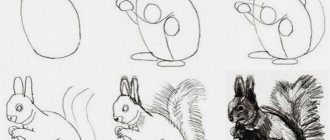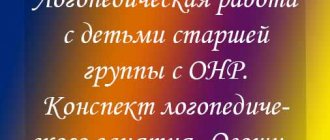Summary of a game educational situation with elements of cognitive development
Municipal budgetary preschool educational institution
kindergarten No. 4
municipal formation Kanevsky district
Abstract
integrated activities in the educational field
"Social and communicative development"
on the topic:
“Visiting Aunt Cossack”
prepared by: teacher Klimenko N.I.
2017
Software tasks:
1. To instill in children a love for their small homeland - Kuban. 2. Expand children’s understanding of everyday life, the way of life of the Kuban Cossacks, continue to introduce them to the world of objects used in everyday life in the old days. Learn to name their functions and purpose.
3. Develop an educational interest in the history of your people.
Integration with educational areas:
“Social and communicative development”, “Artistic and aesthetic development”, “Physical development”, “Speech development”.
Objectives of educational areas:
1. Enrich children’s vocabulary with words: rocker, cast iron, grip, towel, way of life, wisdom, prevarication, gift.
2. Activate the words in children’s speech: generosity, frugality, hard work, accuracy, observation, politeness, hospitality, courage, honesty, kindness, respect, friendliness, love of freedom, independence, pride; 3. Through health-saving technologies, strengthen the physical health of children, form moral and volitional qualities, introduce children to the Kuban outdoor games played by little Cossacks, and evoke a desire to take part in them; 4. Develop an interest in the origins of folk art, instill an interest in making amulets, ritual and game dolls; 5. To introduce to the art of music, to cultivate a love for the musical culture of the Cossacks, to convey to children the beauty of the Cossack song.
Preliminary work
: organized educational activities in a mini-museum, doll making.
Methodical techniques:
verbal methods (teacher's story, questions to children, explanation); visual methods (demonstration of illustrations, video material), practical method.
Equipment:
— mini-museum “Kuban Compound”
- installation of multimedia,
—
audio recording of Kuban lyrical songs,
- costumes for children and teachers (sundresses, shirts) according to the number of participants,
—
To make a doll you will need :
1) identical squares of white and black fabric, 1 piece of each color, approximately 12x12 cm in size. (As an option, you can choose light blue and dark blue, soft purple and dark purple, etc.) .
2) small pieces of cotton wool,
3) red thread,
4) braid or cord for hanging the doll.
Progress of the lesson:
1. Organizational moment.
Educator:
Guys, Aunt Cossack invites us to visit today.
Cossack woman
: (multimedia, video recording. Teacher in a Cossack costume):
The further into the future we go,
The more we value the past.
And we find beauty in the old,
At least we belong to something new
I invite you to my Kuban courtyard, stay, help, and continue our work on making the doll. Our magic ball will show you the way.
Educator:
Here is the ball. Children, do we accept the invitation?
Children:
(Children's response)
Educator:
You roll, roll, ball, from the ravine to the bridge.
Just don’t rush too much, show the path. (The ball rolls, and the children follow it. They end up in the Kuban courtyard.)
2. The main part.
Cossack woman:
Hello, dear guests: beautiful girls and kind fellows!!! I'm glad to see you in my yard. Children:
We came to you with a request - to teach us how to make a talisman for the home.
Cossack girl.
I’ll teach you, but first I want to know what you know about Kuban. You already know a lot about the life and traditions of Kuban. You know a lot of new words. Let's remember them. I will describe the object to you, and you will have to tell me it.
-The house where our ancestors lived (hut)
-This is a clay object in which milk does not sour for a long time (glachik)
-With the help of these two wooden objects, the clothes of the Cossacks were always ironed (ruble and gurney)
-What did you knead the dough in? (in makitra)
-Water was brought from ....(well)
-We drank delicious tea from…..(samovar)
-They cooked delicious porridge in this item and was it very heavy? (cast iron)
— To put the cast iron into a hot oven or take it out of the oven, what did you use? (Grip)
-And with the help of this item and bread they greet guests (rushnik)
- Today we will get acquainted with a new item in the house.
The grandmother hides her things there—boots, a caftan, a frock coat. . . Tell me everything together, This closet is called ... (chest)
Cossack woman:
Guys, this is a chest
(there is a chest in the corner of the hut, the children approach it).
Look, the chest is locked with a key. This is a chest, this is a chest, a marvel—a marvelous thing, probably, in such chests the only thing to be stored is the countless treasures that are awarded to heroes in fairy tales for their daring and honesty.
Guys, how many of you know what kind of item a chest is and what it is needed for? (children's statements)
Search situation “What could be in the chest?”
Cossack woman:
Our grandmothers kept their outfits and jewelry in chests.
What do you think is stored in this chest? ( children's statements).
Cossack woman:
You and I will play a game
Game situation
: “Pick up and try on suits.” The teacher invites the children to try on Kuban costumes.
The teacher takes clothes for children from the chest one by one: sundresses for girls, shirts for boys. (Children wear Kuban costumes)
a game
Then he takes out the basket
Cossack woman:
Here is our basket of scraps. Now you know that I keep material for our crafts in the chest. Sit down on the bench, we will spin the doll - a talisman.
3. Practical work.
Step-by-step production of a doll-amulet "
Day-night
»
Cossack:
Remember, such a doll needs to be made without scissors and a needle; in the old days it was called “roll” or “twist”. You and I played with dolls. Which ones?
Children. "Pelenashka." "Bell".
Cossack woman:
And today we will make a doll amulet “Day - Night”.
(Form of working together - individual, according to the scheme)
During independent work, Kuban lyrical songs are heard.
Explanation during operation:
“Day and Night” dolls are dolls that protect the home. Dolls protect the change of day and night and order in the world. During the day they put the light one forward, and at night - the dark one. The “Day” doll is young, lively, active, hard-working and cheerful. She is the mistress of the day and makes sure that on weekdays people work, labor, on holidays they have fun, sing, dance, play, so that the sun shines during the day. The doll monitors the lives of people in the light of day, protects the day. So that the day is not wasted, but meaningfully. Then the doll is happy, and everything is fine with the people. The “Night” doll is wise, thoughtful, calm, she is the mistress of the night. The night is a magician. It changes both things and people. She brings another world. Everything is mysterious at night. Everything familiar without sunlight becomes unrecognizable. And people become different. More frank and open. The most heartfelt conversations drag on past midnight. But the main thing is that people sleep at night. The night makes sure that everyone calms down and goes to bed, rests from daytime activities, and gains strength.
4. Analysis and evaluation of the lesson.
Cossack woman:
Well done, what beautiful amulets you have created!
Let's give each other dolls with words of wishes. Let us remember why these dolls were made, what should be desired when giving a doll. ( Health, happiness, prosperity, goodness
.) The doll must be given from the heart, only then will it bring good luck and become a real amulet.
Educator:
I want to give my doll to Arisha. Arisha, I’m giving you a talisman doll so that it can protect your home in Ukraine.
Children give each other dolls with sincere wishes.
APPLICATION:
rice. 1 pic. 2
Place cotton wool in the middle of the squares (Fig. 1). Carefully form the head and tie with red thread (Fig. 2).
rice. 3 fig. 4
Shape the body of the dolls in the same way as the base is made (Fig. 3). Place the resulting pupae together, back to back (Fig. 4).
rice. 5 fig. 6
Wrap red thread in the places where the fabric is wrapped (Fig. 5). Tie a braid or cord to the neck, and you can hang the doll in any convenient place (Fig. 6).
Difficulty in the situation
This stage is key, as it contains at its source the main components of the structure of reflexive self-organization.
Within the framework of the chosen plot, a situation is simulated in which children are faced with a difficulty in their activity: in order to achieve their “children’s” goal, the child needs to perform a certain action, let’s call it a “trial” action. But the implementation of this “trial” action is based on that new knowledge (concept or method of action) that the child has yet to “discover” and which he does not yet have at the moment. This raises a difficulty. The teacher, using a system of questions (“Could you?” - “Why couldn’t you?”) helps children gain experience in recording the difficulty and identifying its cause.
This stage is extremely important from the point of view of the development of personal qualities and attitudes of preschoolers. Children get used to the fact that they should not be afraid of difficulties and failures, that the correct behavior in case of difficulties is not resentment or refusal of activity, but a search for the cause and its elimination. Children develop such an important quality as the ability to see their mistakes and admit: “I don’t know something yet (or I can’t do it).”
Since the difficulty is personally significant for each child (it interferes with the achievement of his “childish” goal), children have an internal need to overcome it, that is, now a new goal associated with cognition (an educational task correlated with an “adult” goal ).
In early preschool age, at the end of this stage, the teacher himself voices the goal of further cognitive activity in the form “Well done, you guessed correctly! So, we need to find out...” Based on this experience (“we need to find out”) in the older groups, a very important question arises from the point of view of solving the general task of education – the formation of the ability to learn: “What do we need to learn now?” It is at this moment that children acquire the primary experience of consciously setting an educational goal for themselves, while they pronounce it in external speech.
Thus, following the logic of the stages of technology, the teacher leads children to the point that they themselves want to learn “something.” Moreover, this “something” is absolutely concrete and understandable to children, since they themselves (under the guidance of an adult) just named the cause of the difficulty.
Comprehension
This stage is a necessary element of any activity, as it allows you to gain experience in performing such important universal actions as recording the achievement of a goal and determining the conditions that made it possible to achieve this goal.
Using a system of questions: “Where were you?”, “What were you doing?”, “Who did you help?” – the teacher helps children comprehend their activities and record the achievement of the “children’s” goal. And then, with the help of questions: “How was it possible?”, “What did you do to achieve the goal?”, “What knowledge (skills, personal qualities) were useful?” – leads children to the conclusion that they achieved their (“children’s”) goal due to the fact that they learned something, learned something, showed themselves in a certain way, that is, brings together the “children’s” and “adult” goals (“Succeeded ... because they found out (learned)...").
“Discovery” of new knowledge (way of action)
At this stage, the teacher involves children in the process of independent search and “discovery” of new knowledge, solving problematic issues.
First, the teacher encourages the children to choose a way to overcome the difficulty. In early preschool age, the main ways to overcome difficulties are to “try to guess for yourself” and/or “ask someone who knows.” In older preschool age, a new method is added - “look in a book,” “come up with it yourself, and then test yourself using a model.” Using various techniques and methods (leading dialogue, stimulating dialogue), the teacher organizes the construction of new knowledge (way of action), which is recorded by children in speech and, possibly, in signs. Thus, children gain experience in choosing a way to overcome a difficulty, putting forward and justifying hypotheses, and “discovering” new knowledge - for now by guessing.
Inclusion of new knowledge (method of action) into the child’s knowledge system
At this stage, the teacher offers various types of activities in which new knowledge or a method of action is used in conjunction with previously mastered ones, or in changed conditions.
At the same time, the teacher pays attention to the children’s ability to listen, understand and repeat the adult’s instructions, and plan their activities (for example, in older preschool age, questions like: “What will you do now? How will you complete the task?”).
Here children acquire primary experience of self-control of their actions and control of the actions of their peers. The use at this stage of such forms of organizing children's activities, when children work in pairs or small groups for a common result, allows preschoolers to develop cultural communication skills and communication skills.
Depending on the program objectives, age and individual characteristics of the children, this stage can be implemented within one lesson (educational situation), or distributed over time.
Updating knowledge and skills
At this stage, in the course of joint activities with children, built within the framework of the implementation of the “children’s” goal, the teacher directs the children’s activities, in which the mental operations, as well as the knowledge and experience of the children, which they need for a new “discovery,” are purposefully updated. Children develop experience in understanding the purpose of an activity, interacting with peers, coordinating actions, identifying and correcting their mistakes. At the same time, children are in their own semantic space (a game plot, for example), moving towards their “children’s” goal and do not even realize that the teacher, as a competent organizer, is leading them to new “discoveries.” Depending on the program objectives, the characteristics of the children in the group, their educational needs, this stage can be either localized in time together with other stages, or carried out separately as the threshold of a specially simulated situation of difficulty.





